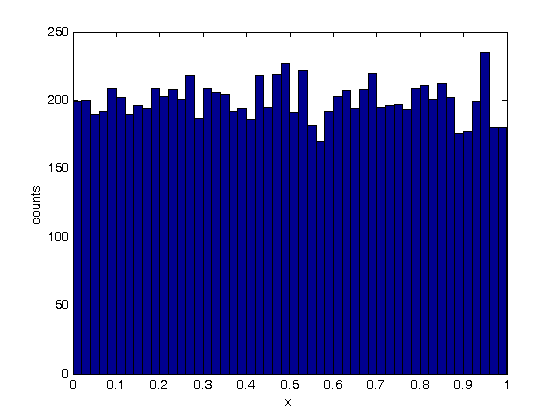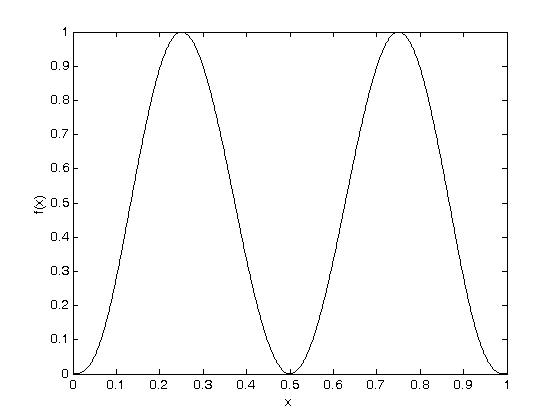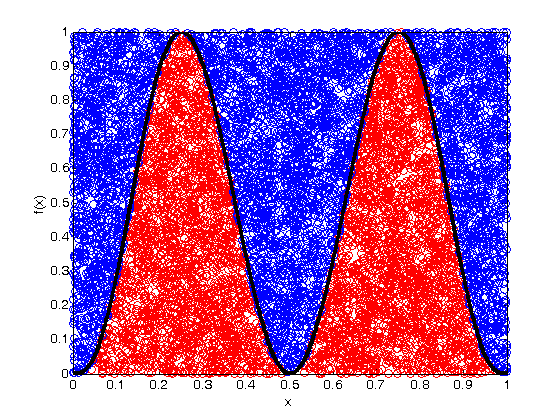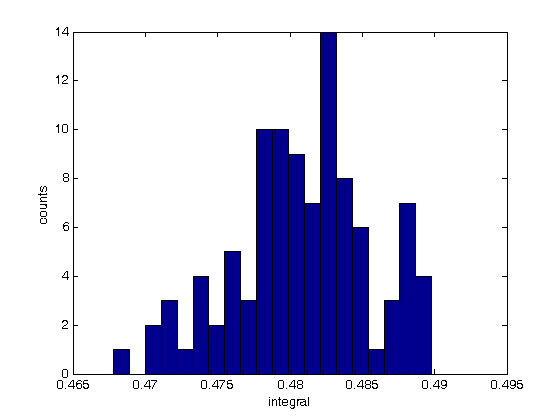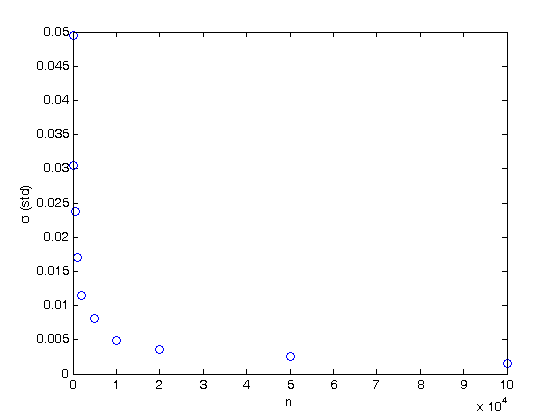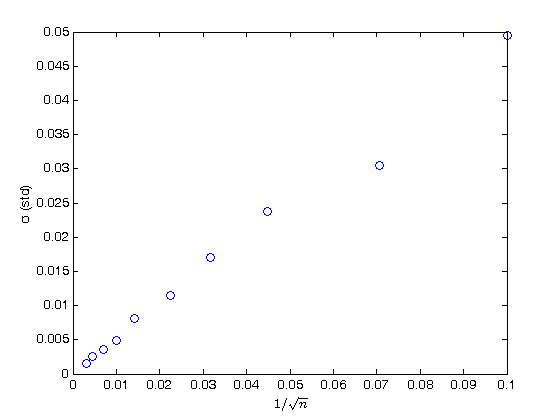% Jake Bobowski % August 15, 2017 % Created using MATLAB R2014a % This tutorial will numerically evaluate a definite integral using the % Monte Carlo Hit & Miss method. clearvars % In all Monte Carlo simulations it is necessary to generate random or % pseudo-random numbers. The MATLAB command "rand" generates random % numbers uniformly distributed between zero and one. Note that, to % generate random numbers drawn from a normal distribtuion, you can use % "randn". rand % To confirm that the numbers generated by rand are uniformly distribted on % the interval [0, 1], we can generate a long list of these numbers and % plot a histogram. rand(n) would return and n by n matrix of random number % while rand(n, 1) returns a column matrix (vector) or n random numbers. x = rand(1e4,1); nbins = 50; hist(x, nbins) % ***IMPORTANT*** MATLAB now encourages users to use histogram() in place % of hist(). However, histogram() does not seem to work in MATLAB 2014. % If you're running a newer version of MATLAB, try using histogram(). xlabel('x'); ylabel('counts'); % This tutorial will first attempt to evaluate an integral for which the % solution is easily obtained. This approach has been taken purposely so % that we can confirm that our numerical techniques are reliable. The % function that we will integrate is a simply polynomial. Below, the % function is plotted on the interval x = [0, 1] and the exact value of the % integral is evaluated over the same interval. We are going to use this % polynomial over and over again in this tutorial, so we define it as a % function. xx = (0:0.001:1); syms x; fcn = @(x) (-65536*x.^8 + 262144*x.^7 - 409600*x.^6 + 311296*x.^5 - 114688*x.^4 + 16384*x.^3)/27; figure(); plot(xx, fcn(xx), 'k-', 'LineWidth', 1.2) xlabel('x'); ylabel('f(x)'); exact = int(fcn, x, 0, 1) % Convert the exact answer, given as a fraction, to a decimal number. vpa(exact) % We now implement is the Hit & Miss numerical integration technique. In % this method pairs of random numbers (x_i, y_i) will be generated. For % the x-coordinate the x_i values will be between 0 and 1 (the integration % interval). Notice that our function of interest always lies between % y = 0..1. Therefore, we will also restrict our y_i values to be between % 0 and 1. The randomly generated points (x_i, y_i) have equal probability % of landing anywhere in the box which has area 1. The probability of a % point landing beneath the function is equal to the area A beneath the % curve (which is just the integral of the function of interest) divided % by the area of the box. Therefore, if we can determine the probability % of a point landing beneath the curve, we can easily approximate the value % of the definite integral. The probability will be estimated simply by % spraying n points into the box and counting how many land beneath the % curve Zn (i.e. counting the Hits). Then the probability p is simply % p = Zn/n. n = 1e4; Zn = 0; misses = 0; for i = 1:n xx = rand; y = rand; if y <= fcn(xx) Zn = Zn + 1; xH(Zn) = xx; yH(Zn) = y; else misses = misses + 1; xM(misses) = xx; yM(misses) = y; end; end; intEst = Zn/n % Plot the function as a line and the add the hits and misses as scatter % plots. figure(); plot(xH, yH, 'ro') hold on; plot(xM, yM, 'bo') xx = (0:0.001:1); plot(xx, fcn(xx), 'k-', 'LineWidth', 3) xlabel('x'); ylabel('f(x)'); hold off; % If you don't need to keep track of the actual coordinates of each hit and % miss, then you can get away with a more compact loop that just counts the % number of hits. n = 1e4; Zn = 0; for i = 1:n xx = rand; y = rand; if y <= fcn(xx) Zn = Zn + 1; end; end; intEst = Zn/n % Now we will numberically approximate the integral using n = 10,000 one % hundred times and plot the resulting distribution of our determination of % the integral. The distribution is expected to be Gaussian. % To take how long this block of codes take to complete, I'll use the %"datestr" function to display the time before and after the loop. datestr(clock) n = 1e4; for j = 1:100 Zn = 0; for i = 1:n xx = rand; y = rand; if y <= fcn(xx) Zn = Zn + 1; end end intList(j) = Zn/n; end datestr(clock) figure(); nbins = 20; hist(intList, nbins) xlabel('integral'); ylabel('counts'); figure(); % Note that it took MATLAB all of 2 seconds to complette this task. The % same code run in Maple on the same machine requires almost 5 minutes to % complete! % The width of the distribution can be calculated from the standard % deviation of the list of 100 approximations of the integral and is an % estimate in the uncertainty of our determination of the definite integral. % Beleive it or not, the name of the fuction to calculate the standard % deviation of a list is "std"! std(intList) % Finally, the last thing we'll attempt to do is to understand how our % uncertainly (standard deviation) depends on the n. So far, all of our % calculations have used n = 1e4. Now we'll determine the standard % deviation for values of n that range from 100 to 1e5. This % block of code could took my laptop about 33 seconds to complete... % If you've got a lot time to kill, trying running the same loop in Maple! datestr(clock) nList = [100, 200, 500, 1000, 2000, 5000, 1e4, 2e4, 5e4, 1e5]; for k = 1:length(nList) n = nList(k); for j = 1:100 Zn = 0; for i = 1:n xx = rand; y = rand; if y <= fcn(xx) Zn = Zn + 1; end end intList(j) = Zn/n; end nList(k) sigmaList(k) = std(intList); end datestr(clock) % Below we plot the uncertainty in the numerical integral estimation as % a function of n (the number of trials in the Monte Carlo simulation). % As expected, the uncertainty decreases as the number of trials increases. % The sigma values are proportional to 1/sqrt(n). plot(nList, sigmaList, 'bo') xlabel('n') ylabel('\sigma (std)') % To get a better appreciation of the dependence of sigma on n, below we % plot sigma as a function of 1/sqrt(n) and observe the linear relationship % between the two. Beautiful! All of this generated from uniformly % distributed random numbers! Take a moment to reflect on what we've % accomplished. We've used Monte Carlo simulations to study the behaviour % of Monte Carlo simulations! The objective of a Monte Carlo calculation % is always to study the characteristics of some system (often a physical % system) by simulating data using random numbers. figure(); plot(1./sqrt(nList), sigmaList, 'bo') xlabel('1/$$\sqrt{n}$$', 'Interpreter', 'latex') ylabel('\sigma (std)')
ans =
0.8377
exact =
4096/8505
ans =
0.48159905937683715461493239271017
intEst =
0.4782
intEst =
0.4767
ans =
16-Aug-2017 09:09:21
ans =
16-Aug-2017 09:09:55
ans =
0.0047
ans =
16-Aug-2017 09:09:55
ans =
100
ans =
200
ans =
500
ans =
1000
ans =
2000
ans =
5000
ans =
10000
ans =
20000
ans =
50000
ans =
100000
ans =
16-Aug-2017 09:20:46
